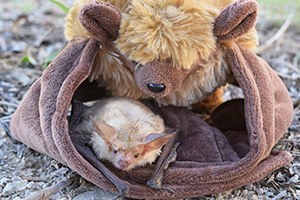Animal Fact Sheet: Cactus Wren |
|
Identifying Features The Cactus wren (Campylorhynchus brunneicapillus) has a white eye stripe just behind each eye extending to just before its upper back. Its throat and breast are heavily spotted dark brown and black, and its wings and tail are barred with black, white and brown feathers. Its overall appearance is a creamy colored brown bird with varied black and white patterns covering its body. Its beak is slightly curved. |
 |
Adaptations While the female is incubating on clutch of eggs, the male wren builds another nest. This nest will be used or a second clutch of eggs as the parents may rear several broods of young in one year. Building the nest in cactus provides some amount of protection for the young. The wrens also use these nest throughout the year as places to roost. |
Habitat They are found in deserts and arid foothills that have cactus, mesquite, yucca and other types of desert scrub. |
Range The cactus wren can be found in Arizona, southern California, southern Nevada, western Texas, southwest Utah, and north-central Mexico. |
Wild Status The cactus wren is not currently listed as endangered or threatened. It is however, like all songbirds, protected by the Migratory Bird Treaty Act. |
Diet The cactus wren eats many types of food often turning over rocks or other objects it finds on the ground in search of tasty morsels. Fruit pulp, seeds, ants, grasshoppers, beetles, and other arthropods make up its diet. |
Predators Coachwhips and other whipsnakes are able to navigate their way through the cactus and often will take eggs or nestlings. Adult birds can be food for coyotes, hawks, fox, bobcats or domestic cats. |
Home Cactus wrens build nests that are the size and shape of a football with an opening at one end. They will construct this nest out of grasses and other annual plants, but can also include scraps of cloth and other woven fibers that they find. They will build this nest (and many others) usually in cholla, but also in palo verde, acacias, saguaros, or the hanging pot in your backyard. |
Life Span In the wild cactus wrens can live to be 7-10 years old. |
Size This is a large member of the wren family being 7-8 inches in length. |
Quick Facts
|
 ©Copyright 2008, Arizona-Sonora Desert Museum
©Copyright 2008, Arizona-Sonora Desert Museum










